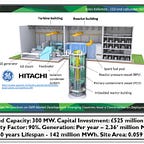“…There is No Such Thing As Renewable Energy…”
Mark P Mills pulls the plug on Intermittent Electricity from ‘Renewables’
At 11:49 “…There is no such thing as Renewable Energy..……..all energy is free…”
Meaning: The energy locked inside uranium is as freely available to humanity as the energy locked inside the wind and in sunlight.
It only becomes useful to us when we: (i) Procure the rights to land or seabed to ‘mine’ that energy (ii) Build machines to extract the energy and turn it into electricity or heat.
ALL MACHINES WEAR OUT. There is nothing renewable about machines wearing out. They are, in fact, all REBUILDABLES!
~~~~~~~~~~~~~~~//~~~~~~~~~~~~~~~
In my earlier Blogpost about the CCC’s Sixth Carbon Budget, the ‘name of the game’ is generating 635 TWh per year of low-carbon, 24/7/365 electricity by 2050.
From 2030, advanced NPPs, factory-manufactured by Rolls-Royce, will be commercially financed and available. A single 470 MW UK SMR generates 3.7 TWh per year of low-carbon, 24/7/365 electricity from a 0.04 km² site, for a 60-year lifespan.
172 UK SMRs would generate 635 TWh per year, for 60 years, occupying 6.88 km² of land area.
~~~~~~~~~~~~~~~//~~~~~~~~~~~~~~~
In their Sixth Carbon Budget the CCC specify:
95 GW of Offshore Wind capacity +46.77% overbuild = 139 GW
90 GW of Solar +46.77% overbuild = 132 GW
37 GW of Onshore Wind +46.77% overbuild = 54 GW
These machines generate low-carbon electricity, but only in the intermittent form. To overcome the Intermittency Problem a P2G2P backup infrastructure requires greenH2-fuelled gas turbine to deliver the essential 24/7/365 form:
206 GW of CCGT capacity is required.
~~~~~~~~~~//~~~~~~~~~
To get the direct comparison with advanced NPPs, generation over a period of 60 years is necessary:
Offshore wind turbine generators (WTGs) have a lifespan of 25 years.
Solar panels have a lifespan of 30 years.
Onshore WTGs have a lifespan of 25 years.
CCGTs have a lifespan of 25 years.
60 ÷ 25 ≡ x2.4~~~~~60 ÷ 30 ≡ x2.0
~~~~~~~~~~//~~~~~~~~~~
The final totals for the numbers of each of the machines are:
Offshore Wind: 139 x 2.4 = 334 GW (33,400 x 10 MW Offshore WTGs)
Solar: 90 x 2.0 = 180 GW (452,570,000 Solar Panels)
Onshore Wind: 37 x 2.4 = 89 GW (18,542 x 4.8 MW Onshore WTGs)
GreenH2-fuelled CCGTs: 206 x 2.4 = 494 GW (1235 x 400 MW CCGTs)
~~~~~~~~~~//~~~~~~~~~~
On the assumption that new machines will be rebuilt on the same sites as decommissioned machines, the lifespan factors need not apply. The land and seabed areas required are:
139 GW of Offshore Wind ≡ 129 ‘Seagreens’ = 50,550 km²
132 GW of Solar ≡ 377 ‘Cleve Hills’ = 1,357 km²
54 GW of Onshore Wind ≡ 225 ‘South Kyles’ = 4,500 km²
206 GW of CCGTs ≡ 103 ‘Pembrokes’ = 55 km²
~~~~~~~~~~~~~~~//~~~~~~~~~~~~~~~
Total Rebuildables (Machines) to generate 635 TWh of low-carbon, 24/7/365 electricity, for 60 years, from the energy in Uranium: 172
Land Area Occupied: 6.88 km²
Total Rebuildables (Machines) to generate 635 TWh of low-carbon, 24/7/365 electricity, for 60 years, from the energy in Wind & Solar: 53,177 + 452,570,000 Solar Panels
Land Area Occupied: 5,912 km² + Seabed Area Occupied: 50,550 km²
~~~~~~~~~~~~~~~~~~~//~~~~~~~~~~~~~~~~~~~
